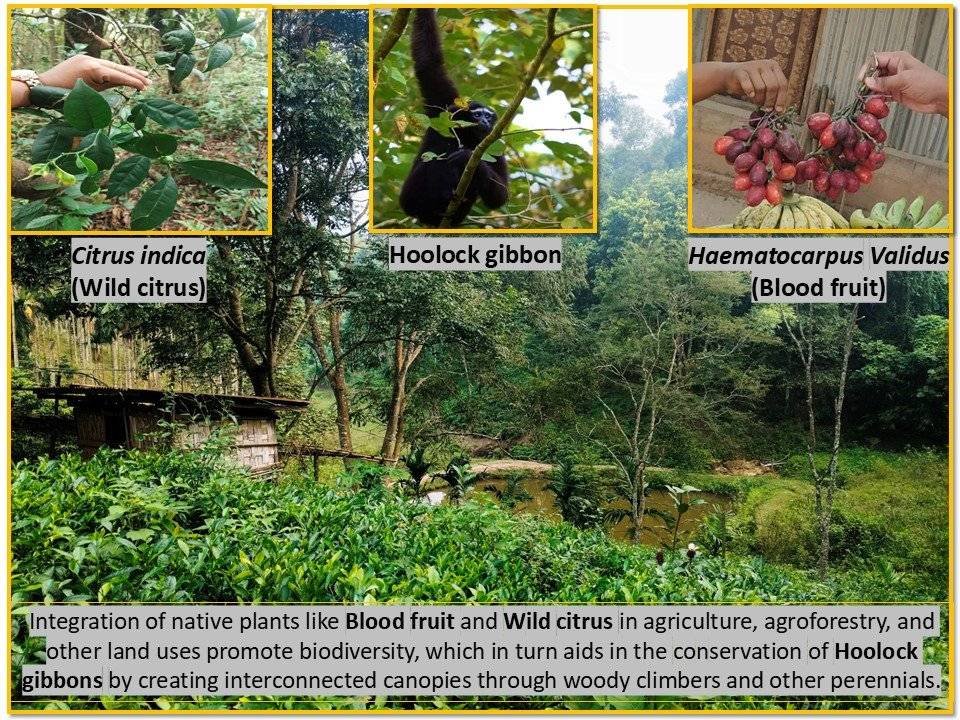Background
The Northeastern region is experiencing a decline in its endangered flora and fauna, including Citrus indica, Haematocarpus validus, and the Hoolock gibbon, as these species confront the threat of extinction in the Anthropocene epoch. All three endemic species are categorized as endangered on the IUCN Red List. According to the India State of Forest Report (ISFR) 2021, significant forest cover loss is seen in Arunachal Pradesh (257 sq km), Manipur (235 sq km), Mizoram (186 sq km), and Meghalaya (73 sq km). This loss is driven by shifting cultivation, tree felling, and other anthropogenic activities, leading to habitat degradation and fragmentation that threatens endemic and endangered species. If the same situation continues, there is no doubt about the extinction of these three species in the coming years. These species need special and immediate attention for conservation due to their endemism and high degree of threat. Therefore, it is a wake-up call for all the stakeholders, including local communities, government, and research institutes, to take immediate conservation measures.
Citrus indica
The endangered Citrus indica, or the “Indian wild orange,” is the most primitive citrus species and the progenitor of cultivated citrus. Although earlier studies reported its presence in Nagaland, Meghalaya, and Assam, recent studies revealed its occurrence in the Tura range in the Garo Hills of Meghalaya and a few species in the Behali Reserve Forest of Assam. This species has an intricate relationship with the Garo people; fruits are used as folk medicine to treat smallpox and jaundice, and hold spiritual significance in burial rites. This is also a potential source of citrus rootstock for cultivated citrus. Yet, it has multifarious benefits. The natural population has drastically declined due to large-scale habitat destruction, high habitat specificity, low regeneration capacity, and extremely low genetic diversity. To protect this, the “Citrus Gene Sanctuary” was established in Meghalaya’s Nokrek Biosphere Reserve, but increasing human activity and slow regeneration continue to endanger the species.
Further reading: https://whereagroforestrymeetsagriculture.com/the-lost-legacy-of-citrus-indica-preserving-north-east-indias-heritage-fruit/
Hoolock gibbon
The endangered Hoolock hoolock, or the “Hoolock Gibbon”, the only ape found in India, inhabits the monsoon and evergreen rainforests of North East India, Bangladesh, Myanmar, and southern China. It plays an important role in maintaining forest biodiversity as a pollinator, seed disperser, and player of other important ecological roles. It is known for being the smallest and fastest ape and is arboreal, frugivorous, and practices brachiation and monogamy. Its diet includes mostly fruits, but it also eats leaves, buds, flowers, and animal prey. A study on the gibbon diet in Assam recorded that gibbons are highly frugivorous, spend most of their feeding time eating fruits, and show a preference for lianas, a woody climber. In Meghalaya, several ethnic communities believe harming gibbons brings bad luck, illness, and disgrace, while their presence brings good fortune and prosperity. The population, now at 12,000, has declined by more than 90 % in three decades, mainly due to habitat fragmentation and its monogamous nature.
Haematocarpus validus
Another endemic-endangered key species, Haematocarpus validus, or “Blood fruit”, is a medicinally significant woody climber and holds considerable importance in traditional diets, folk medicine, and local livelihoods. The juice of its bright red berries yields a natural dye, providing an eco-friendly alternative for textile dyeing in the region. It is used in folk medicine, primarily to treat conditions like fever, gastrointestinal disorders, and blood-related ailments. The plant significantly contributes to the local biodiversity and supports various insects and animals. Researchers are increasingly interested in studying the bioactive compounds, reproductive cycle, cultivation, and sustainable harvesting measures. The decline of blood fruit in Northeast India can be attributed to several interrelated ecological and human-driven factors, namely habitat loss and deforestation, overharvesting, climate change, and lack of conservation awareness. These factors reduce the plant’s ability to regenerate and maintain stable population numbers.
Further reading: https://whereagroforestrymeetsagriculture.com/blood-fruit-heamatocarpus-validus-for-health-heritage-and-livelihoods/
Agroforestry Gibbon Corridor: A Proposed Conservation Measure, including other General Measures
Conservation through reforestation and restoration of fragmented habitats is essential for providing continuous forest cover, which links the isolated populations of gibbons and other species. It is necessary to identify and plant gibbon-preferred key food and shelter species to improve the available habitat to gibbon populations through agroforestry and community forestry interventions. Integration of key food and shelter species like blood fruit, citrus, fig, mango, haritaki, jackfruit, and climbing crops in areca nut monocropping can not only provide food for frugivorous gibbons but also improves agro biodiversity, carbon sequestration, soil health, and socio-economic conditions of the local community. In addition, strictly arboreal habits (living in trees) and brachiate (movement from one tree branch to another) need continuous tree canopy cover, which can be achieved through agroforestry gibbon corridors. To protect habitats, it is important to limit deforestation, shifting cultivation, illegal mining, and encroachment. Regular population monitoring and behavioral studies are crucial for adapting conservation strategies based on ecological needs. Establishing captive breeding programs and eventual reintroduction to safe habitats are needed as a long-term strategy.
For species like Citrus indica and Haematocarpus validus, both in-situ and ex-situ methods are needed, including gene sanctuaries, nature reserves, gene parks, seed banks, and inclusion of these species in social and agroforestry. Inclusion in artificial conditions can safeguard this valuable genetic resource and further its evolution. Developing various regeneration methods like air layering, grafting, and micropropagation can accelerate successful propagation and immediate flowering and fruiting.
Apart from habitat protection and restoration, educating and involving local communities in conservation through sustainable practices like community forestry and agroforestry is crucial for achieving benefits for both people and wildlife, ensuring a win-win solution for both human and ecological systems
Trending blog: https://whereagroforestrymeetsagriculture.com/blood-fruit-heamatocarpus-validus-for-health-heritage-and-livelihoods/

